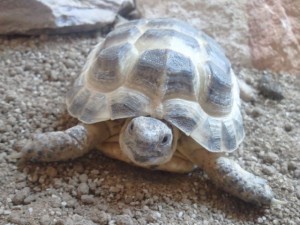This month we have a guest blog post all about tortoises. If you are considering getting one as a pet then here is a great guide that will tell you all about them. At Not Just Pets we stock everything you need to keep them happy and healthy.
What is the Average Lifespan of a Pet Tortoise?

Did you know that the world’s oldest tortoise is 184, that you can measure their length using just a pen and piece of paper and that they can live so long because of their slow metabolism?
For more fun facts about tortoises and to learn how to care for them, read this article provided by ExoticDirect.
The world’s oldest tortoise
The world’s oldest tortoise is called Jonathan, and he’s a whopping 184 years old! A Seychelles Giant Tortoise he lives on St Helena, which is a British outpost in the south Atlantic. Jonathan has lived on the island since 1882, when he arrived there aged 50.
….And the UK’s oldest tortoise
One of the UK’s oldest tortoises was Thomas who lived to the ripe old age of 130. He passed away in Guernsey after being bitten by a rat.
He was reportedly born in 1882, and survived five monarchs including Queen Victoria King Edward VII, King George V, King Edward VIII and George VI.
He also would have been witness (so to speak) of the sinking of the Titanic, the First and Second World Wars and England’s World Cup win 1966.
How long do tortoises live?
Tortoises have a remarkably long life span – and if cared for appropriately can live as long as humans and longer. Check out our list below…..
| Type of Tortoise | Lifespan |
| Horsefield (Testudo Horsefieldi) and subspecies | 60+ years |
| Hermanns (Testudo Hermanni) and subspecies | 100+ years |
| Spur Thighed (Testudo graeca) and subspecies | 100+ years |
| Leopard Tortoise and subspecies | 80+ years |
| Marginated Tortoise and subspecies | 100+ years |
| Indian Star Tortoise | Up to 80 years |
| Sulcata Tortoise or African Giant Spurred Tortoise or Sahel Tortoise | 100+ years |
Why do tortoises live so long?
It’s believed that Tortoises live so long because of their slow metabolism, which can be linked to their slow movement.
In contrast, animals with a fast metabolic rate (and who move around very quickly), can have shorter lives.
It’s said the faster you move, the more energy you burn, and the faster your metabolic rate. Fast moving mammals like shrews can be lucky to live for 2 years; hummingbirds the same.
How do you age a tortoise?
There’s no real way of determining a tortoise’s age, other than through record keeping.
Contrary to some old wives tales, the growth rings around scutes are not a gauge for age.
It’s reported that the rings represent carapace growth spurts that occur during times of quality food abundance. When food is scarce, the carapace doesn’t grow.
What’s the average size of a 6 month old tortoise?
This can vary depending on the species, however a 6 month old Hermann’s tortoise can measure around 4 to 5 cm. The size of a tortoise is influenced by a range of factors including what they eat, and how often and when they were hatched.
What should my tortoise weigh?
Weight alone doesn’t necessarily give an accurate picture of how well your tortoise is growing. Weight along with your tortoise’s length should be used as a measure.
For owners of Mediterranean Spur-Thighed Tortoises (Testudo Graeca) and Hermanns Tortoises (Testudo Hermanni) the Jackson’s Ratio can be used.
This calculates the weight to length ratio and produces a figure appropriate for your tortoise. It was developed as a hibernation guide. It should never be used for other breeds, as it will produce incorrect results.
If you own a Horsefield Tortoise its advised that you can use the McIntyres Ratio to calculate an ideal weight.
The ratio should only be used as a guide, as it was developed using a small sample of tortoises.
How should I measure my tortoise?
You should measure the straight carapace length – the underside of the shell, from front to back. To do this you should:
- Place an A4 piece of paper up against a wall.
- Place your tortoise on the paper, with its shell touching the wall. It’s head should be tucked inside the shell.
- Mark the paper where the back end of the shell finishes
- Measure the distance from the wall to the mark on the paper to gain a carapace measurement.
For younger tortoises you can do this four times a year, for older ones you can do it once or twice a year.
You can weigh your tortoise by placing them on digital kitchen scales. You should weigh them monthly.
You should keep accurate records of the results, which can help you understand how well your tortoise is growing. The records can also be passed to your vet if needed.
Tortoise age and weight for hibernation
Not all breeds of tortoises hibernate and the age from which you should hibernate your tortoise varies depending on who you talk to.
Hibernation isn’t so much about age, but the weight and length of your tortoise (the size), and its health.
It needs to have enough energy reserves to be able to survive hibernation. Hibernating an underweight tortoise could put him into grave danger. Your tortoise should also be fit and healthy.
When hibernating tortoises, some owners wait until their tortoise is 3 years old or 100mm in plastron length.
It’s advised that you keep hatchlings awake during the winter, in appropriate heated surroundings. A tortoise table or run should be suitable.
Some tortoise experts also recommend you don’t hibernate your tortoise within 12 months of ownership, regardless of its age.
To check whether your tortoise is the right size for hibernation you can use the Jackson’s ratio for Mediterranean Spur-Thighed Tortoises (Testudo Graeca) and Hermanns Tortoises (Testudo Hermanni).
For the Horsefield tortoise you can use the McIntyres Ratio (remember McIntyres should only be a guide).
For other tortoise breeds you should be keeping accurate weight and length records, which can be used to gauge whether your tortoise is at the right weight for hibernation. If you’re not sure, you can always speak to your vet.
At what age does a tortoise stop growing?
The growth of a tortoise isn’t connected to its age. Instead, a tortoise will grow until it reaches a certain size, usually specific for their sub species.
The British Chelonia Group provide care sheets which details the sizes that various tortoise species can grow to.
- A Hermann’s (Testudo Hermanni) will stop growing at a carapace length of around 20cm
- A Marginated Tortoise (Testudo Marginata) will stop growing at a carapace length of 25-30cm
- A Hinge back tortoise (Kinixys) will stop growing at a carapace length of 25.4cm
- A Sulcata or African Giant Spurred tortoise can reach 50cm. In fact they are the largest mainland tortoise and can weight over 100lbs.
- A Leopard Tortoise (Geochelone pardaliscan) stop growing at a carapace length of 60cm.
- A male Horsefield Tortoise (Testudo Horsefieldii) can grow to between 15 -25cm in size. Females tend to be larger than males. Horsefield’s are amongst the smallest of the tortoise species.
Buying an old tortoise
If you’re buying an old tortoise you should ensure it is fit and healthy. We suggest the following:
- Your tortoise’s eyes should be clear and open
- His mouth should be dry. There should be no signs of any breathing issues, bubbling around the mouth or wheezing.
- The tortoise’s tongue should be healthy and pink
- After a month old the shell should be firm. It shouldn’t feel soft or spongy. It should however still have some spring in it in the first year.
- The shell should be undamaged with no cracks or splits
- There should be no sign of wounds on the head, neck or legs
- The tail area should be clean, and any faeces shouldn’t be loose or runny
- If in a warm environment, the tortoise should be active
- The tortoise should walk with its shell (plastron) clear of the ground
- The nostrils should be clear and not blocked
- There should be no sign of head swelling
Any sign of illness should be taken seriously. If the tortoise is ill, then do not buy. If you’ve already purchased the tortoise, then you should seek medical help.
Buying an old Tortoise and the Convention on International Trade in Endangered Species (CITES)
Whether you’re buying an old or young tortoise, you should check whether it’s listed as an Annex A animal under CITES. If it is, you’ll need an Article 10 Certificate.
It’s illegal to buy or sell an Annex A listed animal without an Article 10 certificate. These can either be Transaction Specific or Species Specific Certificates.
If your tortoise is listed under Annex B it won’t need a certificate.
What else to know before buying an old tortoise
You should ensure you purchase your tortoise from a reputable retailer or breeder. Forums can be a good place to find out about reputable retailers and breeders, and online research.
You should ask the pet seller for the history of the pet, particularly if the tortoise is old.
Ask about previous medical history – it may be an idea to ask for a copy of the medical history. The pet seller may be able to obtain this from their vet.
You should find out if pet seller has a history of breeding and selling the tortoise species. This will indicate their ‘breed knowledge’ and whether the correct husbandry has been provided
A pet seller will also be interested in your tortoise knowledge. They should ask you questions to ensure you know what you’re taking on. Don’t let this put you off.
Visit the pet seller’s home to ensure that care standards are suitable for tortoises.
Your pet seller should be able to offer you lots of advice and guidance on tortoise care. You should visit the pet sellers premises or home to see the environment that the pet has been kept in
Do your research, and make sure you know enough about the living and food needs for you tortoise
Finally, ask the pet seller lots of questions. They should offer information freely and knowledgeably.
And finally a little trivia…
How old are the tortoises at Chester Zoo?
The four Galapagos Giant Tortoises at Chester Zoo were hatched in 2001, making them 15 years old (as of 2016).

Here at Not Just Pets we endorse responsible pet ownership and advise all our customers on the best possible set ups and we sell all the products suggested in the article. This guest blog post about tortoises promotes that as well as fitting in with the Not Just Pet ethos of ‘they’re not just pets, they’re family!’
We look forward to welcoming you in store soon; remember we are open in our Bath store 7 days a week!
Any ideas and suggestions you have will be welcomed. You can follow us in many ways:
We are now on Instagram! – notjustpets Follow us and see some fantastic photos!
We run regular photo competitions, quizzes, offers and promotions on our Facebook and Twitter pages, so why not “like” or “follow” us today!
Get in touch via any of the above, or via our website or email at bathpets@aol.com or telephone us on 01225 461461. Or simply pop in, you’ll be welcome!

